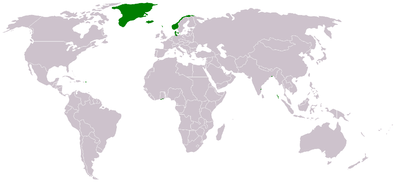Danish Gold Coast
| Danish Gold Coast Danish Guinea | ||||||||||
| Danske Guldkyst Dansk Guinea | ||||||||||
| Denmark-Norway crown colony (1658–1814) Denmark territory (1814–1850) | ||||||||||
| ||||||||||
| ||||||||||
 | ||||||||||
 | ||||||||||
| Capital | Osu (Christiansborg) (1658–1850) | |||||||||
| Languages | Danish, German (official) Ga, Dangme, | |||||||||
| Political structure | Denmark-Norway crown colony (1658–1814) Denmark territory (1814–1850) | |||||||||
| King of Denmark | ||||||||||
| • | 1658–1670 | Frederick III of Denmark | ||||||||
| • | 1670–1699 | Christian V of Denmark | ||||||||
| • | 1699–1730 | Frederick IV of Denmark | ||||||||
| • | 1730–1746 | Christian VI of Denmark | ||||||||
| • | 1746–1766 | Frederick V of Denmark | ||||||||
| • | 1766–1808 | Christian VII of Denmark | ||||||||
| • | 1808–1839 | Frederick VI of Denmark | ||||||||
| • | 1839–1848 | Christian VIII of Denmark | ||||||||
| • | 1848–1863 | Frederick VII of Denmark | ||||||||
| Governor-General | ||||||||||
| • | 1658–1659 | Hendrik Carloff | ||||||||
| • | 1847–1850 | Rasmus Eric Schmidt | ||||||||
| History | ||||||||||
| • | Denmark annexation from Sweden | 1658 | ||||||||
| • | Treaty of Copenhagen | 1660 | ||||||||
| • | Disestablished | March 30, 1850 | ||||||||
| Currency | Danish rigsdaler | |||||||||
| ||||||||||
| Today part of | | |||||||||
The Danish Gold Coast (Danish: Danske Guldkyst or Dansk Guinea) denotes the colonies that Denmark-Norway controlled in Africa as a part of the Gold Coast (roughly present-day southeast Ghana), which is on the petroleum and natural gas rich Gulf of Guinea. It was colonized by the Dano-Norwegian fleet, first under indirect rule by the Danish West India Company (a chartered company), later as a crown colony of the kingdom of Denmark-Norway.
Following the Norwegian Declaration of Independence in 1814, Denmark's five Danish Gold Coast Territorial Settlements and forts of the Kingdom of Denmark were sold to the United Kingdom and were incorporated into the British Gold Coast in 1850.
History

On April 20, 1663, the Danish seizure of Fort Christiansborg and Carlsborg (Cape Castle) completed the annexation of the Swedish Gold Coast settlements. From 1674 to 1755 the settlements were administered by the Danish West India-Guinea Company. From December 1680 to 29 August 1682, the Portuguese occupied Fort Christiansborg.
In 1750 it was made a Danish crown colony. From 1782 to 1785 it was under British occupation. On 30 March 1850 all of Denmark's Danish Gold Coast Territorial Settlements and forts of the Kingdom of Denmark were sold to Britain and incorporated into the British Gold Coast.
The title of its chief colonial administrator was Opperhoved (singular; sometimes rendered in English as Station Chief) since 1658, only in 1766 upgraded to Governor.
Forts and settlements
Main forts
The following forts were in the possession of Denmark until all forts were sold to the United Kingdom in 1850.
| Place in Ghana | Fort name | Founded/ Occupied |
Ceded | Comments |
|---|---|---|---|---|
| Accra | Fort Christiansborg | 1658 | 1850 | First captured from the Swedes in 1658. Occupied between 1680 and 1682 by the Portuguese. Sold to the United Kingdom in 1850. |
| Old Ningo | Fort Fredensborg | 1734 | 1850 | Sold to the United Kingdom in 1850. |
| Keta | Fort Prinsensten | 1784 | 1850 | Sold to the United Kingdom in 1850. |
| Ada | Fort Kongensten | 1784 | 1850 | Sold to the United Kingdom in 1850. |
| Teshie | Fort Augustaborg | 1787 | 1850 | Sold to the United Kingdom in 1850. |
Temporarily held forts and trading posts
Apart from these main forts, several forts and trading posts were temporarily held by the Danes.
| Place in Ghana | Fort name | Founded/ Occupied |
Ceded | Comments |
|---|---|---|---|---|
| Cape Coast | Fort Carlsborg | 1658 | 1664 | Captured from the Swedes in 1658. Captured by the British in 1664. |
| Amanful | Fort Frederiksborg | 1659 | 1685 | |
| Cong | Cong Heights | 1659 | 1661 |
See also
- Colonial Heads of Danish Gold Coast the office-holders of the Danish Gold Coast
Sources and references
Further reading
- Closing the Books: Governor Edward Carstensen on Danish Guinea, 1842-50. Translated from the Danish by Tove Storsveen. Accra, Ghana: Sub-Saharan Publishers, 2010.

.svg.png)
.jpg)
.svg.png)